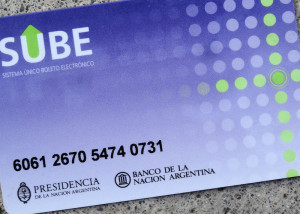Reading about other peoples’ woes can be strangely satisfying, so read on…
Buenos Aires suffers under a cloud of its own bureaucracy and it played an unpleasingly large role in my stay. It was the dog-shit on my shoe. Thousands are employed to stuff each other around long enough to be deemed full time and bingo! Low unemployment! As a foreigner, if you need to interact with anything loosely government connected, whether that’s the national postal service, national airlines, or AFIP (government authority) – be prepared to be fucked around and waste whole chunks of days achieving nothing. Take a number, a chair, and wait….
To catch public transport without the universal automated touch-card system called SUBE, one must pay double, and in coins. The cost is not the issue – in fact I commend the government for making the public transport cheap and accessible to almost all. It’s the coins which are very hard to find in any quantity. Supermarkets have prices like – $15.60 (pesos) and implore exact change, or round up and down to a clean number leaving you without coins to catch the bus. So I wanted to get me one of them there SUBE cards. Must be a breeze as everyone’s got one – I thought. Yes, they confirmed. It was easy. All I had to do was go to the nearest post office. Brilliant!
The post office was closed – Easter week off. Hmmmm. But I still want to get around and see the place. Tough. Do you have $3.25? Coins only.
Ok, Easter Sunday done, tomorrow I get the card. Monday public holiday, Tuesday public holiday. Wednesday in post office…
‘Mañana’.
‘What? What do you mean ‘tomorrow?”
He waived me away. ‘Next’.
Post office branch two… (after 20 mins in queue)…
‘Yes sure, DNI please (National Identity Card)’.
Do I look like a local? Ok, bad question in Buenos Aires but…Do I sound like a local?
‘Passport? No, we don’t do passports here. Go to Avenida Corrientes 314’.
$3.25, coins only.
Day two. Avenida Corrientes 314.
‘No, you can’t buy the SUBE here,’ the SUBE t-shirt waring lady tells me from behind the SUBE kiosk stand.
‘What is this then? Advocacy?’ I’m thinking to myself. By this point I was laughing.
‘You have to go to SUBE HQ, Avenida Callao 316’.
$3.25, coins only. Coins? What coins?
Avenida Callao 316.
‘Sí señor, you can buy a SUBE card here, but you can’t pay with cash – credit or debit card only.’
‘OK, ok, just gimmee!’
‘Passport Señor.’
‘Here it is, and here’s my credit card. Bill me! Please.’
‘It has a chip, Sr.’
‘Yes, it has a chip’
‘Our machines are old; they don’t take cards with chips.’
‘Ummm, right. And I can’t pay with cash.’
‘No cash Señor.’
Walls closing in around me.
‘Wait a moment.’ He beckons someone over, asks if his card can be used and I pass him the cash’. An agreement is reached.
SOLUTION.
 This clerk didn’t have to offer me an out. His little book of bureaucracy could have had me turfed out onto the street to wallow in my own despair but his moment of recognition of my dilemma and his willingness to ask on my behalf solved my whole mess.
This clerk didn’t have to offer me an out. His little book of bureaucracy could have had me turfed out onto the street to wallow in my own despair but his moment of recognition of my dilemma and his willingness to ask on my behalf solved my whole mess.
Sun shines through the window, birds chirping. I had done it. I was the proud owner of my very own SUBE card. Let the exploration begin…
Sending a 3kg parcel to Santiago was much the same, but not quite as depressing. I just had to do a lot of walking around and waiting. I was quoted USD200 by DHL, USD150 by FedEx – are these people nuts? I’m sending a few jumpers, some Mates, a book and shirt that don’t even amount to 200 US. For that reason I persisted, and got fit in search of another option, which I eventually found at the 4th branch I went to of the Correo Argentino – 2.7kg – $26 US. That’s more like it.
Buying a plane ticket in Bariloche to go to Buenos Aires was strangely straight forward – the cost was only 100 pesos more than the web and it was done quickly without a fuss. Arrive in Buenos Aires and cheerily see web prices from Buenos Aires to Iguazú for $126, and from Iguazú to Salta in north western Argentina (close to the Bolivian border) for about the same. Total 2,200 pesos, more or less. I arrive expecting something in the vicinity of that price and am cheerily informed it would cost me 7,800 pesos. Why? Because I was a foreigner. I actually burst out laughing in front of the lady, pointed out the ridiculous price difference and asked her if she was serious. I then just walked out. There comes a point, beyond which I loose the pretext of being polite. Apparently this is not new in Argentina – where travel for locals is subsidised by foreigners who pay much higher prices. This happens when government stipulates prices to the state-linked airline which has a monopoly on domestic routes where it loses money providing the low fares to citizens but is free to make it back on the unregulated international market. As I write this, a five day driver strike on all inter-region bus services has just ended with the government raising airline prices on domestic routes by a further 16% across the board.


